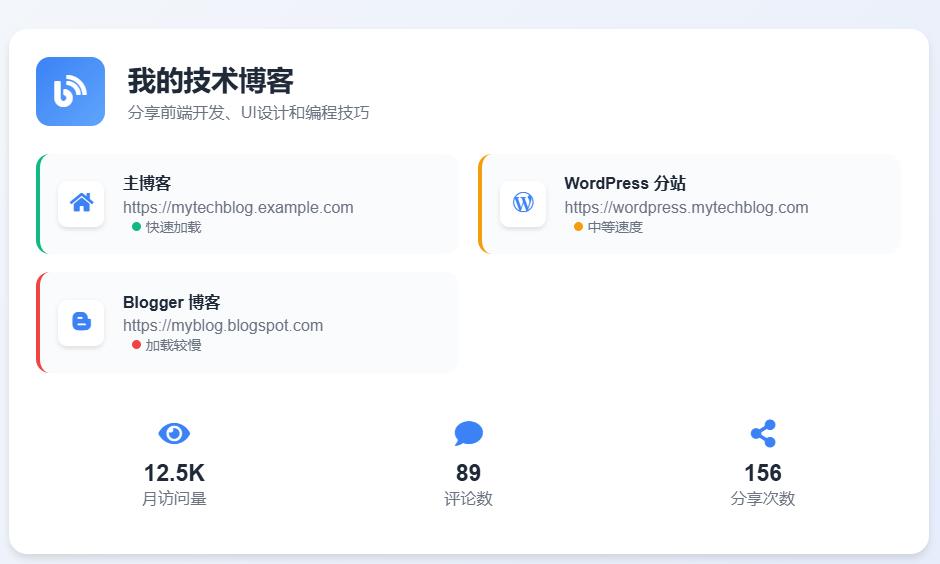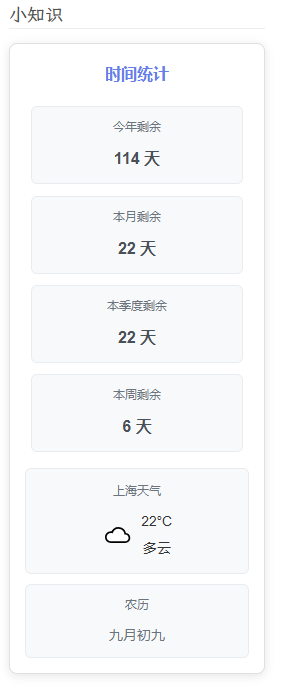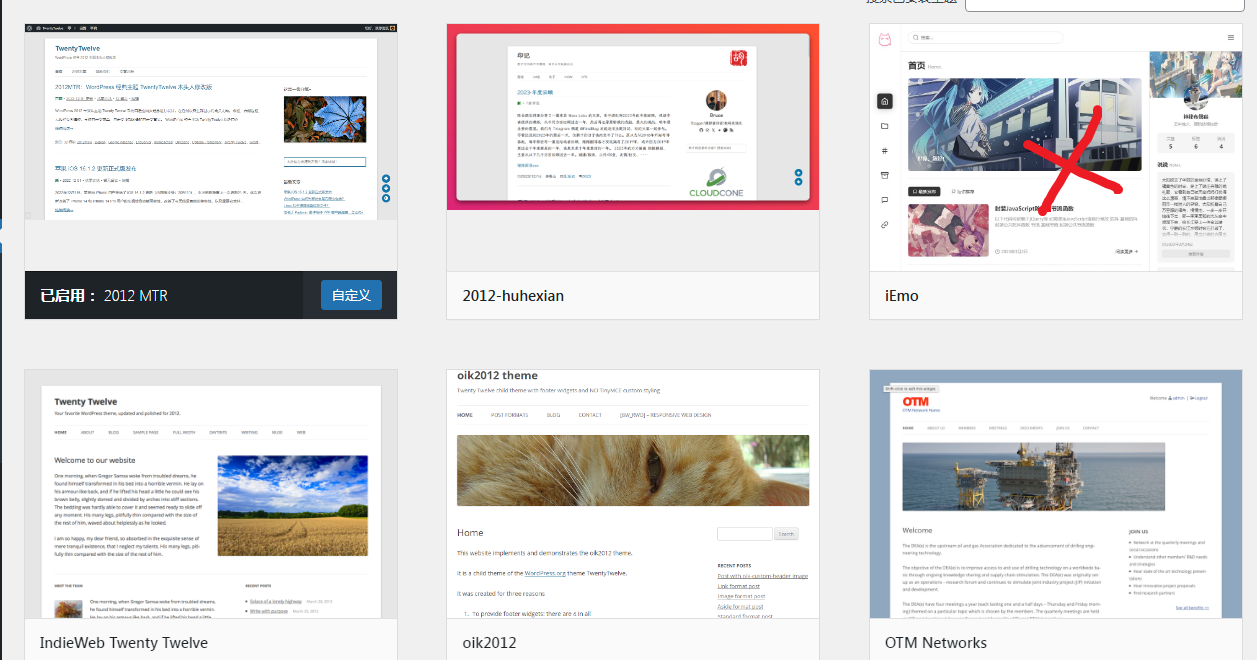这个是我用智谱清言AI出来的结果,觉得还不错:
在WordPress经典编辑器中,你可以直接使用HTML代码来创建表格。以下是一个简单表格的代码示例,你可以直接复制到文章的文本编辑器中:
一般代码:
<table border="1">
<tr>
<th>标题1</th>
<th>标题2</th>
<th>标题3</th>
</tr>
<tr>
<td>内容1</td>
<td>内容2</td>
<td>内容3</td>
</tr>
<tr>
<td>内容4</td>
<td>内容5</td>
<td>内容6</td>
</tr>
</table>
使用方法:
- 在WordPress编辑器中,点击"文本"标签切换到HTML视图
- 将上面的代码粘贴进去
- 切换回"可视化"视图查看效果
- 根据需要修改表格内容和样式
这种方法不需要任何插件,直接使用HTML和CSS就能创建美观的表格。
能否添加边框颜色?
想使用其他颜色,可以修改这些颜色代码:
#4285f4- 蓝色边框#1a73e8- 深蓝色边框(表头)#e8f0fe- 鼠标悬停背景色
你也可以使用其他颜色,比如:
- 红色边框:
#e74c3c - 绿色边框:
#27ae60 - 紫色边框:
#9b59b6 - 橙色边框:
#f39c12
只需将CSS中的颜色代码替换成你喜欢的颜色即可。
你可以根据需要调整以下背景颜色:
- 整体表格背景色:
#ffffff(白色) - 表头背景色:
#3498db(蓝色) - 偶数行背景色:
#f2f9ff(浅蓝色) - 奇数行背景色:
#e6f3ff(稍深的浅蓝色) - 鼠标悬停背景色:
#d1e7ff(中浅蓝色) - 高亮单元格背景色:
#fff2cc(浅黄色)
如果你想使用其他颜色,可以替换这些颜色代码。例如:
- 绿色系:
#2ecc71,#a9dfbf,#d5f4e6 - 红色系:
#e74c3c,#f1948a,#fadbd8 - 紫色系:
#9b59b6,#d7bde2,#f4ecf7
只需将相应的颜色代码替换成你喜欢的颜色即可。
下面是一个添加颜色的完整的表格代码:
示意图:链接
<style>
.custom-table {
width: 100%;
border-collapse: collapse;
margin: 20px 0;
background-color: #ffffff; /* 整体表格背景色 */
}
.custom-table th, .custom-table td {
border: 2px solid #4285f4; /* 蓝色边框 */
padding: 8px;
text-align: left;
}
.custom-table th {
background-color: #3498db; /* 表头背景色 */
color: #ffffff; /* 表头文字颜色 */
font-weight: bold;
border-color: #1a73e8; /* 表头边框颜色 */
}
.custom-table tr:nth-child(even) {
background-color: #f2f9ff; /* 偶数行背景色 */
}
.custom-table tr:nth-child(odd) {
background-color: #e6f3ff; /* 奇数行背景色 */
}
/* 鼠标悬停效果 */
.custom-table tr:hover {
background-color: #d1e7ff; /* 鼠标悬停背景色 */
}
/* 特定单元格背景色 */
.custom-table .highlight {
background-color: #fff2cc; /* 高亮单元格背景色 */
}
</style>
<table class="custom-table">
<tr>
<th>标题1</th>
<th>标题2</th>
<th>标题3</th>
</tr>
<tr>
<td>内容1</td>
<td class="highlight">内容2</td> <!-- 这个单元格会使用高亮背景色 -->
<td>内容3</td>
</tr>
<tr>
<td>内容4</td>
<td>内容5</td>
<td>内容6</td>
</tr>
</table>
要让表格更美观,添加一些高级样式和设计元素,示图链接:
<style>
.beautiful-table {
width: 100%;
border-collapse: collapse;
margin: 25px 0;
font-size: 16px;
font-family: 'Arial', sans-serif;
box-shadow: 0 4px 8px rgba(0,0,0,0.1);
border-radius: 8px;
overflow: hidden;
}
.beautiful-table thead tr {
background-color: #2c3e50;
color: #ffffff;
text-align: left;
font-weight: bold;
}
.beautiful-table th, .beautiful-table td {
padding: 12px 15px;
border: none;
}
.beautiful-table tbody tr {
border-bottom: 1px solid #dddddd;
}
.beautiful-table tbody tr:nth-of-type(even) {
background-color: #f3f3f3;
}
.beautiful-table tbody tr:last-of-type {
border-bottom: 2px solid #2c3e50;
}
.beautiful-table tbody tr:hover {
background-color: #e8f4fc;
font-weight: 500;
}
/* 添加响应式设计 */
@media screen and (max-width: 600px) {
.beautiful-table {
display: block;
overflow-x: auto;
}
}
/* 添加斑马纹效果 */
.beautiful-table tbody tr:nth-of-type(odd) {
background-color: #ffffff;
}
/* 添加表格标题样式 */
.table-caption {
font-size: 18px;
font-weight: bold;
color: #2c3e50;
margin-bottom: 10px;
text-align: center;
}
</style>
<div class="table-caption">精美表格示例</div>
<table class="beautiful-table">
<thead>
<tr>
<th>标题1</th>
<th>标题2</th>
<th>标题3</th>
</tr>
</thead>
<tbody>
<tr>
<td>内容1</td>
<td>内容2</td>
<td>内容3</td>
</tr>
<tr>
<td>内容4</td>
<td>内容5</td>
<td>内容6</td>
</tr>
<tr>
<td>内容7</td>
<td>内容8</td>
<td>内容9</td>
</tr>
</tbody>
</table>
上面这个表格设计包含了以下美化元素:
- 圆角边框:使用
border-radius和overflow: hidden创建圆角效果 - 阴影效果:添加
box-shadow使表格看起来有立体感 - 更好的字体:指定了字体族和大小
- 表头设计:深色背景配白色文字,更加醒目
- 行间距:增加了单元格内边距,使内容更加舒适
- 悬停效果:鼠标悬停时行会高亮显示
- 斑马纹:奇偶行使用不同背景色,提高可读性
- 表格标题:添加了表格标题样式
- 响应式设计:在小屏幕设备上可以水平滚动
如果你想进一步自定义,可以调整:
- 颜色方案:修改
background-color和color值 - 间距:调整
padding和margin值 - 字体:更改
font-family和font-size - 阴影效果:调整
box-shadow的参数
这种设计既美观又实用,适合大多数网站使用。
要让表格适应不同屏幕尺寸,
我们可以使用响应式设计技术。以下是一个响应式表格的代码示例,相关示意图:
<style>
.responsive-table-container {
width: 100%;
overflow-x: auto;
margin: 25px 0;
}
.responsive-table {
width: 100%;
border-collapse: collapse;
margin: 0;
font-size: 16px;
font-family: 'Arial', sans-serif;
box-shadow: 0 4px 8px rgba(0,0,0,0.1);
border-radius: 8px;
overflow: hidden;
}
.responsive-table thead tr {
background-color: #2c3e50;
color: #ffffff;
text-align: left;
font-weight: bold;
}
.responsive-table th, .responsive-table td {
padding: 12px 15px;
border: none;
}
.responsive-table tbody tr {
border-bottom: 1px solid #dddddd;
}
.responsive-table tbody tr:nth-of-type(even) {
background-color: #f3f3f3;
}
.responsive-table tbody tr:hover {
background-color: #e1e1e1;
}
/* 媒体查询,针对小屏幕设备 */
@media screen and (max-width: 768px) {
.responsive-table {
font-size: 14px;
}
.responsive-table th, .responsive-table td {
padding: 8px 10px;
}
/* 可选:在小屏幕上隐藏某些列 */
/* .responsive-table td:nth-child(3), .responsive-table th:nth-child(3) {
display: none;
} */
}
/* 媒体查询,针对极小屏幕设备 */
@media screen and (max-width: 480px) {
.responsive-table {
font-size: 12px;
}
.responsive-table th, .responsive-table td {
padding: 6px 8px;
}
}
</style>
<div class="responsive-table-container">
<table class="responsive-table">
<thead>
<tr>
<th>标题1</th>
<th>标题2</th>
<th>标题3</th>
</tr>
</thead>
<tbody>
<tr>
<td>内容1</td>
<td>内容2</td>
<td>内容3</td>
</tr>
<tr>
<td>内容4</td>
<td>内容5</td>
<td>内容6</td>
</tr>
<tr>
<td>内容7</td>
<td>内容8</td>
<td>内容9</td>
</tr>
</tbody>
</table>
</div>
这个响应式表格设计包含以下关键特性:
- 容器滚动:使用
overflow-x: auto确保在小屏幕上可以水平滚动查看完整表格 - 媒体查询:
- 针对平板设备(768px以下)调整字体大小和内边距
- 针对手机设备(480px以下)进一步减小字体和内边距
- 可选列隐藏:在代码中注释了如何在小屏幕上隐藏某些列,如果需要可以取消注释并调整
- 百分比宽度:表格宽度设置为100%,确保充分利用可用空间
- 弹性内边距:在不同屏幕尺寸上使用不同的内边距值
其他优化建议:
- 考虑表格内容:如果表格有很多列,可以考虑:
- 重新组织数据,减少列数
- 使用缩写或图标代替长文本
- 将次要信息移至工具提示或详情页面
- 替代方案:对于非常复杂的表格,可以考虑:
- 在小屏幕上将表格转换为卡片式布局
- 使用JavaScript实现更复杂的响应式行为
- 测试:在不同设备和屏幕尺寸上测试表格显示效果,确保用户体验良好
这种响应式设计方法确保你的表格在各种设备上都能良好显示,无论是桌面电脑、平板还是手机。
能否添加个按键,我可以自行添加行和列呢
相关示意图
<style>
.table-container {
width: 100%;
overflow-x: auto;
margin: 25px 0;
}
.editable-table {
width: 100%;
border-collapse: collapse;
margin: 0;
font-size: 16px;
font-family: 'Arial', sans-serif;
box-shadow: 0 4px 8px rgba(0,0,0,0.1);
border-radius: 8px;
overflow: hidden;
}
.editable-table thead tr {
background-color: #2c3e50;
color: #ffffff;
text-align: left;
font-weight: bold;
}
.editable-table th, .editable-table td {
padding: 12px 15px;
border: 1px solid #ddd;
}
.editable-table tbody tr {
border-bottom: 1px solid #dddddd;
}
.editable-table tbody tr:nth-of-type(even) {
background-color: #f3f3f3;
}
.editable-table tbody tr:hover {
background-color: #f1f1f1;
}
.table-controls {
margin: 15px 0;
}
.control-btn {
background-color: #3498db;
color: white;
border: none;
padding: 8px 15px;
margin-right: 10px;
border-radius: 4px;
cursor: pointer;
font-size: 14px;
transition: background-color 0.3s;
}
.control-btn:hover {
background-color: #2980b9;
}
@media screen and (max-width: 768px) {
.editable-table {
font-size: 14px;
}
.editable-table th, .editable-table td {
padding: 8px 10px;
}
}
</style>
<div class="table-container">
<div class="table-controls">
<button class="control-btn" onclick="addRow()">添加行</button>
<button class="control-btn" onclick="addColumn()">添加列</button>
</div>
<table class="editable-table" id="dynamicTable">
<thead>
<tr id="headerRow">
<th>标题1</th>
<th>标题2</th>
<th>标题3</th>
<th>标题4</th>
<th>标题5</th>
</tr>
</thead>
<tbody id="tableBody">
<tr>
<td>内容1-1</td>
<td>内容1-2</td>
<td>内容1-3</td>
<td>内容1-4</td>
<td>内容1-5</td>
</tr>
<tr>
<td>内容2-1</td>
<td>内容2-2</td>
<td>内容2-3</td>
<td>内容2-4</td>
<td>内容2-5</td>
</tr>
<tr>
<td>内容3-1</td>
<td>内容3-2</td>
<td>内容3-3</td>
<td>内容3-4</td>
<td>内容3-5</td>
</tr>
<tr>
<td>内容4-1</td>
<td>内容4-2</td>
<td>内容4-3</td>
<td>内容4-4</td>
<td>内容4-5</td>
</tr>
<tr>
<td>内容5-1</td>
<td>内容5-2</td>
<td>内容5-3</td>
<td>内容5-4</td>
<td>内容5-5</td>
</tr>
<tr>
<td>内容6-1</td>
<td>内容6-2</td>
<td>内容6-3</td>
<td>内容6-4</td>
<td>内容6-5</td>
</tr>
<tr>
<td>内容7-1</td>
<td>内容7-2</td>
<td>内容7-3</td>
<td>内容7-4</td>
<td>内容7-5</td>
</tr>
</tbody>
</table>
</div>
<script>
function addRow() {
const table = document.getElementById('tableBody');
const rowCount = table.rows.length;
const colCount = table.rows[0].cells.length;
const row = table.insertRow(rowCount);
for (let i = 0; i < colCount; i++) {
const cell = row.insertCell(i);
cell.contentEditable = true;
cell.textContent = `新内容-${rowCount+1}-${i+1}`;
}
}
function addColumn() {
const table = document.getElementById('dynamicTable');
const headerRow = document.getElementById('headerRow');
const bodyRows = document.getElementById('tableBody').rows;
const colCount = headerRow.cells.length;
// 添加表头
const headerCell = headerRow.insertCell(colCount);
headerCell.textContent = `标题${colCount+1}`;
// 为每一行添加新单元格
for (let i = 0; i < bodyRows.length; i++) {
const cell = bodyRows[i].insertCell(colCount);
cell.contentEditable = true;
cell.textContent = `内容${i+1}-${colCount+1}`;
}
}
</script>
使用方法:
- 在WordPress编辑器中,点击"文本"标签切换到HTML视图
- 将上面的代码粘贴进去
- 切换回"可视化"视图查看效果
- 点击"添加行"或"添加列"按钮来扩展表格
- 直接点击表格单元格可以编辑内容
这个表格具有以下特点:
- 初始为五列七行的布局
- 带有"添加行"和"添加列"按钮,可以动态扩展表格
- 表格单元格可直接编辑(点击后输入内容)
- 响应式设计,适应不同屏幕尺寸
- 表格行有交替背景色,提高可读性
- 鼠标悬停时有高亮效果
注意:由于WordPress可能会过滤一些JavaScript代码,如果按钮不起作用,你可能需要安装一个允许自定义JavaScript的插件,或者检查你的WordPress设置是否允许执行JavaScript代码。我用html代码测试过了,效果




![[Windows] Excel列运算工具 V1.0.0 可视化Excel数据处理工具-Puo's 菜园子](https://s21.ax1x.com/2025/09/01/pVgSSRH.md.png)





